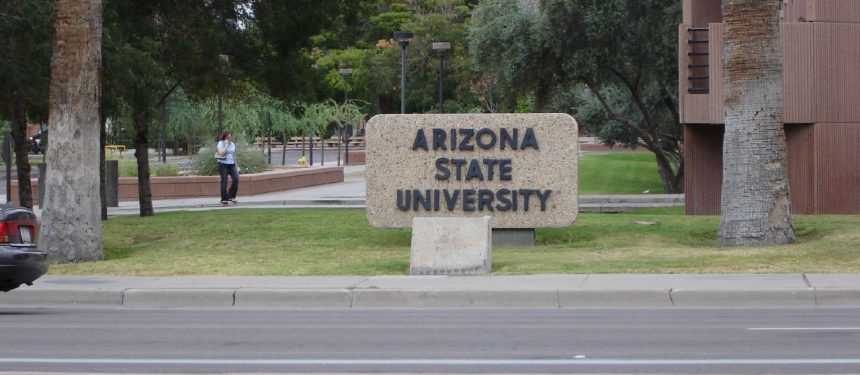With US-Mexico relations on tenterhooks, longstanding higher education partnerships between the two countries are at a “critical juncture”, the American Council on Education has said.
News and business analysis for Professionals in International Education
Have some pie!
US-Mexico HE relationships at a ‘critical juncture’, says ACE
 Arizona State University is among the five US universities the report picks out as having particularly comprehensive links with Mexican institutions. Photo: Flickr/Esparta Palma.
Arizona State University is among the five US universities the report picks out as having particularly comprehensive links with Mexican institutions. Photo: Flickr/Esparta Palma. In a new report, the organisation urges Mexican and US universities and colleges to bolster support for faculty-led engagement and learn to work together to address issues of safety, access and reciprocity to ensure the long-term sustainability of cross-border collaboration.
Fortifying higher education links is crucial at a time when “tensions between the two countries are at the highest point in decades”, argues the report, which catalogued and analysed an inventory of engagement activities between US and Mexican higher education institutions.
“Reciprocity among partners is a key element of sustainability”
“The considerable resources and energy devoted to increasing collaboration in recent years, coupled with new challenges posed by the rapidly shifting political environment, make this a critical juncture in the US-Mexico higher education relationship.”
The report advocates for “a policy and programmatic emphasis on building sustainable partnerships—and enhancing the sustainability of existing activities”.
“Reciprocity among partners is a key element of sustainability,” the report argues, but notes that not all partnership agreements are functionally two-way.
This is illustrated in student flows: in many student and faculty exchange programs, it is unclear whether student flows are balanced or if one institution acts as the primary ‘sender’ and one as the ‘receiver’.
Meanwhile, not all programs are two-way. Students from the US tend to spend time in Mexico via semesters, short-term study abroad or service learning. The inventory included 92 one-way study abroad programs sending US students to Mexico, including several that take place at US institutions’ “outposts” in Mexico.
In contrast, Mexican students are far more likely to carry out a full degree at a US university – 17,052 were enrolled on degree or certificate courses in 2014/15, according to IIE’s Open Doors data.
Program sustainability is a major concern; of more than 800 partnership agreements between US and Mexican institutions compiled by report sponsor Banco Santander/Universia in 2013, only a quarter were still active three years later.
Many of these issues are largely down to – or at least exacerbated by – a lack of institution-wide coordination.
The report identifies faculty as a major driving force behind cross-border partnerships, with initiatives often coordinated by individual faculty members.
The need to shore up structural support for faculty engagement is one of the most critical findings of ACE’s report, said Robin Helms, director of ACE’s Center for Internationalization and Global Engagement.
“Faculty are key drivers of activity, but as we note in the report, the onus really is on them to undertake it,” she said.
ACE found that the current landscape of US-Mexico higher education engagement is largely made up of collaborations involving a single institution or entity in each country, and faculty members pursuing Mexico-focused teaching and scholarship on their own.
“With this solid base in place, there is an opportunity to ‘connect the connections’, and create new networks in order to deepen and expand cross-border engagement,” it urges.
Dedicated institutional centres for engagement can help to provide this support, the report suggests, allowing for coordination of grant applications and fundraising, promotion of programs and sustainability of projects over time rather than relying on individual faculty and staff.
“Faculty are key drivers of activity, but the onus really is on them to undertake it”
The five US institutions identified in the report as having particularly comprehensive, multidimensional links with Mexican counterparts all have a dedicated research centre or other academic unit for Mexico-focused scholarship and activities, it notes.
This idea of ‘connecting the connections’ could also go further to establish links between US institutions that work with Mexican counterparts to strengthen existing partnerships, it says.
“If five different US institutions have exchange programs in different disciplines with the same Mexican institution, for example, it seems like there would be a great opportunity to pool resources, and offer additional programmatic options to students at all five via a consortium-type arrangement,” argued Helms.
This is particularly pertinent given the high concentration of cross-border engagement in certain geographical areas.
The majority of exchange agreements with US institutions take place at just a handful of Mexican institutions, the report found, while on the US side, activity is concentrated in states along the US-Mexico border.
All five of the most actively engaged US institutions are large, publicly funded institutions located in border states, including Arizona State University and the University of California system.
And 55% of Mexican students at US institutions were in 10 metropolitan areas across just six states. Neighbouring Texas was the most popular, with Houston, El Paso and San Antonio hosting the most students.
Non-academic organisations also have a role to play in addressing this issue, by facilitating a wider breadth of engagement and encouraging more diverse partnerships, the report states.
IIE‘s International Academic Partnerships Program, for example, is “making headway in facilitating institution-to-institution connections”, while ACE itself could help to open dialogues between institutions, it says.
Still looking? Find by category:


